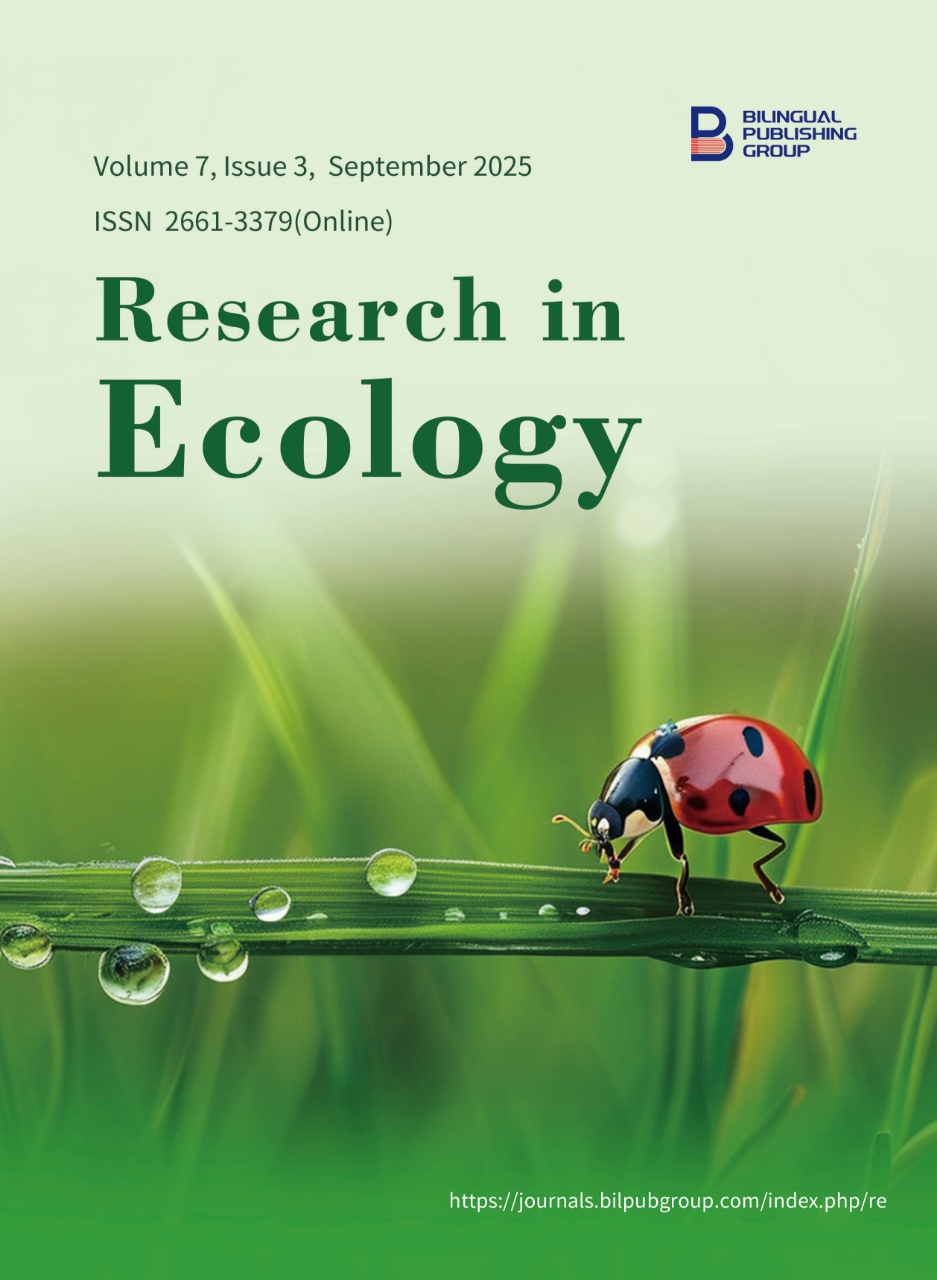
Optimizing Semi-solid Fermentation Substrates for Enhanced Conidia Production of Nomuraea rileyi (Farlow) Samson as a Biopesticides for Insect Control
DOI:
https://doi.org/10.30564/re.v7i3.10479Abstract
Biological insecticides have gained importance in modern society because they cause minimal environmental harm and reduce pests' ability to develop resistance. Nomuraea rileyi, a facultative entomopathogenic fungus, is suitable for infecting lepidopteran pests, including Spodoptera litura and Helicoverpa armigera. This work aims to identify a suitable semi-solid fermentation medium to increase the conidia production of N. rileyi and enhance its biological control ability as mycoinsecticide. Research is carried out on broken rice, wheat, sorghum, and corn as substrates, both with and without nutrient addition. It also covers incubation under set conditions, colony harvesting, and conidial yield and germination determination using a haemocytometer. All the study was conducted using a completely randomized design (CRD) and a test of significance was set at p <0.05 using analysis of variance (ANOVA). This work aimed to establish the effect of various substrates on growth and conidia formation in N. rileyi. The highest conidia count of 10 × 10⁸ CFU/g on day 15. The result was obtained from BR + Nu followed by sorghum 7 × 10⁸ CFU/g, corn 7 × 10⁸ CFU/g and wheat 6.5 × 10⁸ CFU/g. Thus, post-drying, the highest corresponding viability was observed in the product containing BR+Nu – 6.20 ×10⁸ CFU/g. Adding rice bran (BR+RB, 150g each) still increases conidial yield up to 14×108 CFU /g at 15 DAI. These findings thus assert that broken rice and supplementation affect conidia yield and viability.
Keywords:
Nomuraea Rileyi; Biopesticides; Semi-solid Fermentation; Entomopathogenic FungiReferences
[1] Khan, B.A., Nadeem, M.A., Nawaz, H., et al., 2023. Pesticides: impacts on agriculture productivity, environment, and management strategies. In: Emerging Contaminants and Plants: Interactions, Adaptations and Remediation Technologies. Springer: Singapore. pp. 109–134.
[2] Jadhav, V.R., Tagad, C.K., Palake, A., 2024. Economic and commercial aspects related to nanotechnology-based sensors. In: Nanotechnology-Based Sensors for Detection of Environmental Pollution. Elsevier: Amsterdam, Netherlands. pp. 541–552.
[3] Muilu-Mäkelä, R., Brännström, H., Weckroth, M., et al., 2024. Valuable biochemicals of the future: The outlook for bio-based value-added chemicals and their growing markets. Available from: https://jukuri.luke.fi/server/api/core/bitstreams/c3d20b0d-6b23-4e03-9067-da07ec9a366f/content (cited 15 March 2025).
[4] Patil, C., 2021. Microbial inoculants for insect pest management in organic agriculture. In: Biopesticides in Organic Farming. CRC Press: Boca Raton, FL, USA. pp. 269–272.
[5] Sarkar, I., Ghorui, M., Chowdhury, S., et al., 2024. The role of entomopathogenic fungal metabolites in pest management. In: Deshmukh, S.K., Sridhar, K.R. (eds). Entomopathogenic Fungi: Prospects and Challenges. Springer: Singapore. pp. 381–408.
[6] Jaronski, S.T., 2023. Mass production of entomopathogenic fungi—state of the art. In: Mass Production of Beneficial Organisms. Elsevier: Amsterdam, Netherlands. pp. 317–357. DOI: https://doi.org/10.1016/B978-0-12-822106-8.00017-8
[7] Rocha, T.M., Marcelino, P.R.F., Costa, R.A.M.D., et al., 2024. Agricultural bioinputs obtained by solid-state fermentation: From production in biorefineries to sustainable agriculture. Sustainability. 16(3), 1076. DOI: https://doi.org/10.3390/su16031076
[8] Kothari, M., Sandhu, S.S., 2025. Entomopathogenic perspectives of Nomuraea rileyi. In: The Role of Entomopathogenic Fungi in Agriculture. CRC Press: Boca Raton, FL, USA. pp. 140–161.
[9] Mahmood, S., Parwez, H., 2024. The repository of biocontrol agents for Spodoptera frugiperda (Smith, 1797) with emphasis on their mode of action. The Journal of Basic and Applied Zoology. 85(1), 18.
[10] Ahmad, T., Rasool, A., Gull, S., et al., 2019. Ascomycota and integrated pest management. In: Khan, M., Ahmad, W. (eds). Microbes for Sustainable Insect Pest Management. Springer: Cham, Switzerland. pp. 151–183. DOI: https://doi.org/10.1007/978-3-030-23045-6_5
[11] Yadav, V., Lekkala, M.M.V.S.N., Surekha, C., et al., 2020. In: Yadav, A., Mishra, S., Kour, D., Yadav, N., Kumar, A. (eds). Agriculturally Important Fungi for Sustainable Agriculture. Fungal Biology. Springer: Cham, Switzerland. pp. 313–346.
[12] Ilondu, E., Enwemiwe, V., 2020. Entomopathogenic fungi: diversity and their application as biopesticidal agents. Nigerian Journal of Mycology. 12(2), 1.
[13] Sharma, R., Sharma, P., 2021. Fungal entomopathogens: a systematic review. Egyptian Journal of Biological Pest Control. 31, 1–13.
[14] Mascarin, G.M., Golo, P.S., de Souza Ribeiro-Silva, C., et al., 2024. Advances in submerged liquid fermentation and formulation of entomopathogenic fungi. Applied Microbiology and Biotechnology. 108(1), 451. DOI: https://doi.org/10.1007/s00253-024-13287-z
[15] Challa, S., Dutta, T., Neelapu, N.R.R., 2019. Fungal white biotechnology applications for food security: opportunities and challenges. In: Yadav, A., Singh, S., Mishra, S., Gupta, A. (eds). Recent Advancement in White Biotechnology Through Fungi. Fungal Biology. Springer: Cham, Switzerland. pp. 119–148.
[16] Ginting, S., Sunardi, T., Rup, A.M., 2021. Potential of entomopathogenic fungal culture filtrate Nomuraea rileyi (Farlow) Samson (Hypocreales: Clavicipitaceae) in Bengkulu, Indonesia against corn pest Spodoptera frugiperda (JE Smith)(Lepidoptera: Noctuidae). Available from: https://www.cabidigitallibrary.org/doi/full/10.5555/20210524277 (cited 20 March 2025).
[17] Colley, T., Sehra, G., Chowdhary, A., et al., 2018. In vitro and in vivo efficacy of a novel and long-acting fungicidal azole, PC1244, on Aspergillus fumigatus infection. Antimicrobial Agents and Chemotherapy. 62(5). DOI: https://doi.org/10.1128/aac.01941-17
[18] Gupta, A., Jana, A.K., 2019. Production of laccase by repeated batch semi-solid fermentation using wheat straw as substrate and support for fungal growth. Bioprocess and Biosystems Engineering. 42, 499–512.
[19] El-Aziz, A., El‑Gamal, N.N., Moharam, M.E., et al., 2024. Biosolubilization of rock phosphate by Streptomyces sp. MMA-NRC isolated from rhizospheric soil and assessment of ability on wheat growth promotion: insights from genetic improvement random mutation induction approach. Egyptian Academic Journal of Biological Sciences, Microbiology Section. 16(2), 49–79.
[20] Grijalba, E.P., Espinel, C., Cuartas, P.E., et al., 2018. Metarhizium rileyi biopesticide to control Spodoptera frugiperda: stability and insecticidal activity under glasshouse conditions. Fungal Biology. 122(11), 1069–1076. DOI: https://doi.org/10.1016/j.funbio.2018.08.010
[21] Abiy, T.; Tesfaye, A., 2019. Evaluation and optimization of agro-industrial wastes for conidial production of Metarhizium anisopliae isolates under solid state fermentation. Momona Ethiopian Journal of Science. 11(2), 209–228.
[22] Rämä, T., Quandt, C.A., 2021. Improving fungal cultivability for natural products discovery. Frontiers in Microbiology. 12, 706044.
[23] Uwineza, C., Parchami, M., Bouzarjomehr, M., et al., 2024. Recent developments in the application of filamentous fungus Aspergillus oryzae in ruminant feed. Animals. 14(16), 2427. DOI: https://doi.org/10.3390/ani14162427
[24] Shafiekhani, S., Wilson, S.A., Atungulu, G.G., 2018. Impacts of storage temperature and rice moisture content on color characteristics of rice from fields with different disease management practices. Journal of Stored Products Research. 78, 89–97.
[25] Wahab, A., Muhammad, M., Munir, A., et al., 2023. Role of arbuscular mycorrhizal fungi in regulating growth, enhancing productivity, and potentially influencing ecosystems under abiotic and biotic stresses. Plants. 12(17), 3102. DOI: https://doi.org/10.3390/plants12173102
[26] Etesami, H., 2019. Plant growth promotion and suppression of fungal pathogens in rice (Oryza sativa L.) by plant growth-promoting bacteria. In: Maheshwari, D., Dheeman, S. (eds). Field Crops: Sustainable Management by PGPR. Sustainable Development and Biodiversity, vol 23. Springer: Cham, Switzerland. pp. 351–383. DOI: https://doi.org/10.1007/978-3-030-30926-8_13
[27] Luo, X., Jiang, J.H., Liu, S.L., et al., 2024. Metabolomics analysis of rice fermented by medicinal fungi providing insights into the preparation of functional food. Food Chemistry. 459, 140372. DOI: https://doi.org/10.1016/j.foodchem.2024.140372
[28] Muiru, W.M., Fabiola, P.L., Mbuge, D., et al., 2020. Influence of variety endosperm type and seed moisture content on threshability and mechanical damage of sorghum seeds. Agricultural Science and Technology. 12(2), 171–177.
[29] Capurso, C., 2021. Whole-grain intake in the Mediterranean diet and a low protein to carbohydrates ratio can help to reduce mortality from cardiovascular disease, slow down the progression of aging, and to improve lifespan: a review. Nutrients. 13(8), 2540.
[30] Dias, L.M., dos Santos, B.V., Albuquerque, C.J.B., et al., 2018. Biomass sorghum as a novel substrate in solid‐state fermentation for the production of hemicellulases and cellulases by Aspergillus niger and A. fumigatus. Journal of Applied Microbiology. 124(3), 708–718. DOI: https://doi.org/10.1111/jam.13672
[31] Little, C.R., Perumal, R., 2019. The biology and control of sorghum diseases. In: Sorghum: A State of the Art and Future Perspectives. ASA and CSSA: Madison, WI, USA. pp. 297–346.
[32] Iwanicki, N.S.A., Mascarin, G.M., Moreno, S.G., et al., 2020. Growth kinetic and nitrogen source optimization for liquid culture fermentation of Metarhizium robertsii blastospores and bioefficacy against the corn leafhopper Dalbulus maidis. World Journal of Microbiology and Biotechnology. 36(5), 71. DOI: https://doi.org/10.1007/s11274-020-02844-z
[33] Nishimwe, K., Mandap, J.A.L., Munkvold, G.P., 2020. Advances in understanding fungal contamination in cereals. In: Advances in Postharvest Management of Cereals and Grains. Burleigh Dodds Science Publishing: Cambridge, UK. pp. 31–66.
[34] Mapuranga, J., Zhang, N., Zhang, L., et al., 2022. Infection strategies and pathogenicity of biotrophic plant fungal pathogens. Frontiers in Microbiology. 13. DOI: https://doi.org/10.3389/fmicb.2022.799396
[35] Naeimi, S., Khosravi, V., Varga, A., et al., 2020. Screening of organic substrates for solid-state fermentation, viability and bioefficacy of Trichoderma harzianum AS12-2, a biocontrol strain against rice sheath blight disease. Agronomy. 10(9), 1258. DOI: https://doi.org/10.3390/agronomy10091258
[36] Wang, J., Huang, Z., Jiang, Q., et al., 2023. Fungal solid-state fermentation of crops and their by-products to obtain protein resources: The next frontier of food industry. Trends in Food Science & Technology. 138, 628–644. DOI: https://doi.org/10.1016/j.tifs.2023.06.020
[37] Dietsch, R., Jakobs-Schönwandt, D., Grünberger, A., et al., 2021. Desiccation-tolerant fungal blastospores: from production to application. Current Research in Biotechnology. 3, 323–339. DOI: https://doi.org/10.1016/j.crbiot.2021.11.005
[38] Das, M.M., Abdulhameed, S., 2020. Agro-processing residues for the production of fungal bio-control agents. In: Zakaria, Z., Aguilar, C., Kusumaningtyas, R., Binod, P. (eds). Valorisation of Agro-industrial Residues – Volume II: Non-Biological Approaches. Applied Environmental Science and Engineering for a Sustainable Future. Springer: Cham, Switzerland. pp. 107–126. DOI: https://doi.org/10.1007/978-3-030-39208-6_5
Downloads
How to Cite
Issue
Article Type
License
Copyright © 2025 Xuan Trinh Thi, Mai Lam Thi Xuan, Xuan Le Thi Ngoc , Son Pham Kim, Dao Truong Thanh Quynh

This is an open access article under the Creative Commons Attribution-NonCommercial 4.0 International (CC BY-NC 4.0) License.




 Xuan Trinh Thi
Xuan Trinh Thi






